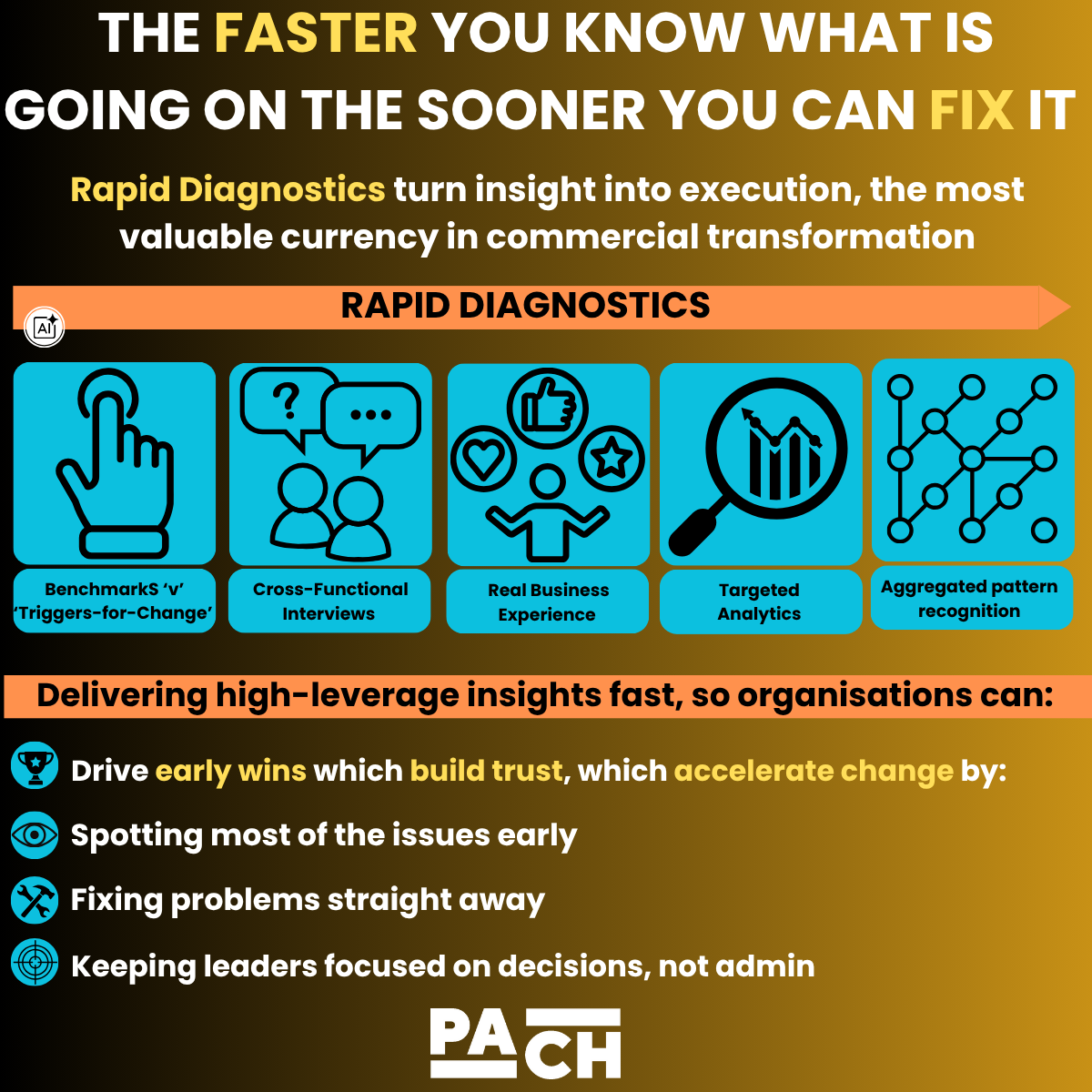SUMMARY
Executive Summary
Commercial transformation doesn’t demand that you fix everything, just that you identify what really matters, and act on it fast enough to make a difference. In transformation, precision and speed aren’t trade-offs; they’re the winning combination.
Building on The Revenue Growth Execution Crisis, this article explores one of its six levers — Rapid Diagnostics — and how combining speed with the quality of insight creates both clarity and momentum.
Key Take-Aways
Traditional diagnostics measured in months are giving way to shorter, high-impact reviews measured in days. The goal is not speed alone, but high-quality insight, delivered faster.
Drawing on 17 years of PACH Solutions’ experience across multiple industries, supported by wider industry research, recurring “triggers-for-change” such as sales effectiveness, channel alignment, planning rhythm, leadership energy, and capability depth show that most barriers to growth are human, not structural.
AI now plays a supporting role, accelerating analysis and pattern recognition, but real progress still depends on human interpretation, conversation, and context.
Organisations that treat diagnostics as the ignition point🔥, not the prelude, move from finding problems to fixing them in record time.
“Clarity delivered fast, and well, is the single greatest competitive advantage.”
Case in Point
In one recent engagement, the entire process, from starting the diagnostic to launching a full commercial change programme, took just ten working days.
Within that timeframe, findings were gathered, analysed, and translated into action; four workstreams were established, each led by an internal manager supported by part-time subject matter experts.
By the end of week two, the client had a clear roadmap, resourced workstreams, and early interventions underway.
The outcome: momentum replaced inertia, and ownership stayed inside the business from day one.
Why It Matters
Markets move faster than ever. When weeks of analysis become days of clarity, leaders can act while energy is still high.
Rapid Diagnostics turn insight into execution, the most valuable currency in commercial transformation.
FULL STORY
THE PROBLEM WITH SLOW DISCOVERY
Traditional consulting diagnostics were designed for a different era, when time was mistaken for rigour and volume implied value. Months of data gathering, endless interviews, and decks heavy enough to impress shareholders but slow enough to lose momentum.
That approach no longer fits today’s pace of business. Across Europe and beyond, senior leaders are demanding faster and sharper visibility into commercial blockages, not 12-week investigations.
McKinsey’s research on “Time to Insight” (2024) shows that companies that compress their discovery cycles by half act on findings three times faster and sustain change longer.
A Gartner 2025 pulse survey found that 68% of transformation programmes stall because diagnostics take too long to align teams and budgets before execution begins.
The conclusion is clear: quality insight, delivered fast, drives credibility and change.
A 17-YEAR EVIDENCE BASE
Over seventeen years of fieldwork, PACH Solutions has seen the same patterns repeat across industries and regions. From manufacturing to services, food to finance, the lessons are consistent, and increasingly supported by wider consulting research:
Most performance barriers are human, not structural. In most cases, problems come down to how people work and behave, not how the business is organised. About 7 out of 10 times, underperformance happens because people aren’t motivated in the right way, messages don’t flow clearly through the organisation, or the culture slows things down, not because the company doesn’t have enough data.
Frontline observation beats spreadsheet analysis. Direct field shadowing and distributor discussions expose the real execution friction points long before analytics do.
Rapid insight builds faster ownership. Teams engage far more when findings are surfaced in days rather than months, while energy and accountability are still high.
These findings align with PwC’s Human-Led, Tech-Powered study (2023), which shows that organisations combining fast, field-based diagnostics with focused analytics achieve 35–40% shorter transformation lead-times than traditional models
WHY RAPID DIAGNOSTICS WORK
Rapid diagnostics are not a cut-down version of consulting, they are a more focused, experience-led form of inquiry. They don’t try to analyse everything; they focus on what really matters, the blockers to growth and the human levers that unlock it.
While some up-front data analysis is valuable to establish performance baselines, the deeper insight comes from:
Cross-functional interviews that benchmark qualitative perspectives against key commercial capabilities.
Recognising patterns, not perfection: identifying consistent themes across functions, not validating every datapoint.
Benchmarking against “Triggers-for-Change”: clear indicators of capability gaps in sales, route-to-market, and planning-to-execution alignment.
Using real business experience and know-how from previous corporate roles to diagnose the issues and deliver solutions quickly
This combination of human interaction, structure, speed, and experience ensures quality is never compromised for pace.
THE ROLE OF AI: THE ACCELERATOR AND AMPLIFIER
Artificial intelligence now supports the rapid diagnostic process by accelerating analysis and pattern recognition, compressing what once took days and weeks into hours. But AI is a tool, not a substitute for judgment. It helps surface the facts faster, but it doesn’t replace the value of human insight, discussion, and alignment.
“CEOs don’t need more data. They need faster clarity. AI helps us surface the facts in hours, not weeks, giving human insight a sharper edge.”
Across the industry, the consensus is clear: technology accelerates, and people interpret.
AI provides the speed and scale; experienced consultants provide the context, creativity, and conviction to turn analysis into action.
PACH Solutions’ field experience reflects the same principle. In rapid diagnostics, human judgment ensures relevance and adoption, and AI strengthens analytical sharpness. Together, they create the conditions for faster, smarter, and more sustainable change.
EMPIRICAL PATTERNS: THE TRIGGERS-FOR-CHANGE
Across industries and regions, five recurring ‘triggers’ consistently appear in rapid diagnostics:
Sales teams losing impact: The way people sell isn’t always linked to what really creates value. Activity is high, but effectiveness is low.
Routes to market not working hard enough: Profits slip away when channels or partners aren’t aligned, or when incentives encourage the wrong behaviours.
Plans and execution out of sync: Marketing and sales often run to different timetables, so what looks good on paper doesn’t land in the field.
Leadership energy fading: Too many priorities, unclear ownership, and change fatigue can slow momentum and blur accountability.
Skills not keeping up: Teams don’t always have the tools, coaching, or confidence to deliver the ambition leaders have set.
These triggers rarely emerge from spreadsheets, they surface in conversations with people who live the business every day.
SPEED AS A COMPETITIVE ADVANTAGE
Recent fieldwork shows that compressed diagnostics can deliver meaningful outcomes in as little as five to ten working days. The key is not speed for its own sake, it’s precision delivered at speed.
When organisations focus early on the few insights that truly matter, they move faster and with greater quality. It’s about shortening the time between seeing the issue and doing something about it, without losing rigour or relevance.
In practice, that means:
Spotting most issues early. Within the first couple of weeks, teams can already see what’s holding growth back, while motivation and momentum are still strong.
Acting immediately. Action starts while the bigger plans are still being finalised, so progress doesn’t wait for paperwork or approvals.
Keeping leaders focused. The process frees up senior time for steering the business, not reviewing slides or reports.
When discovery takes days instead of months, businesses unlock momentum while competitors are still writing their plans. Frontline teams see faster feedback loops, issues are addressed in real time, and leadership confidence rises because progress is visible almost immediately.
The difference is tangible: faster insight, earlier alignment, visible progress.
In short: speed builds belief. Rapid quality insight drives early wins, early wins build trust, and trust accelerates change. The payoff is tangible, faster alignment, earlier traction, and measurable results long before traditional programmes have even left the planning stage.
A MINDSET SHIFT, NOT A METHODOLOGY
The move toward rapid, human-led diagnostics, supported by AI, represents a deeper shift in mindset. Diagnostics are no longer the prelude to transformation, they are the spark that ignites🔥 it.
Long studies reassure. Short, sharp ones mobilise.
AI informs, while people interpret, lead, and act.
And in the end, clarity, not complexity, drives execution.
If this resonates and you’d like to explore how to close the execution gap in your business, click here to learn more.
By Chris Bennfors Founding Partner at PACH Solutions Ltd


